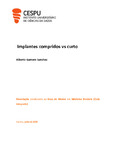Implantes compridos vs curto
Résumé
Introdução: Os implantes dentários são acessórios colocados no osso maxilar ou mandibular para efeitos de reabilitação protética do paciente e podem ser curtos ou compridos.
Objetivos: Realizar uma revisão sistemática para comparar implantes dentários curtos (IMDCs) e implantes dentários compridos (IMDComps) em pacientes com atrofia maxilar, tendo em conta as alterações ósseas marginais, a taxa de sobrevivência e as complicações biológicas e protéticas.
Materiais e Métodos: Foi realizada uma revisão sistemática integrativa, para a qual foram consultadas as bases de dados PubMed, Science Direct e SciELO: PubMed, Science Direct e SciELO, utilizando combinações de palavras-chave, para busca de artigos científicos primários em língua inglesa, dos últimos 10 anos.
Resultados: Foram encontrados 14 artigos científicos. A taxa de sobrevivência mais baixa para IMDCs e IMDComps foi de 91,8% e 84,5%, respetivamente. Dos estudos, 42,8% relataram maior perda óssea marginal nos IMDComp. Dentre as complicações biológicas, destacaram-se a mucosite e a peri-implantite, e dentre as complicações protéticas, o envolvimento direto do parafuso e da coroa artificial.
Discussão: Apesar das diferenças estruturais, podem ser obtidas taxas de sobrevivência semelhantes para ambos os IMDs. A perda óssea é ligeiramente maior nos IMDComp, sem afetar a taxa de sucesso. As complicações têm um comportamento muito semelhante, pelo que podem ocorrer independentemente do comprimento.
Conclusão: Não foram observadas diferenças significativas, tendo em conta a sobrevivência, a perda óssea marginal e as complicações. Por conseguinte, podem ser utilizados com a mesma possibilidade em pacientes que vão ser implantados com ou sem uma combinação de técnicas cirúrgicas. Introduction: Dental implants are attachments placed in the maxillary or mandibular bone for the purpose of prosthetic rehabilitation of the patient and can be short or long.
Objectives: To conduct a systematic review to compare short and long dental implants in patients with maxillary atrophy, considering marginal bone changes, survival rate and biological and prosthetic complications.
Materials and methods: An integrative systematic review was carried out, for which the databases PubMed, Science Direct and SciELO were consulted: PubMed, Science Direct and SciELO, using combinations of key words, to search for primary scientific articles in English language, from the last 10 years.
Results: 14 scientific articles were found. The lowest survival rate for short and long implants was 91.8% and 84.5%, respectively. Of the studies, 42.8% reported greater marginal bone loss in IMDComps. Among the biological complications, mucositis and peri-implantitis stood out, and among the prosthetic complications, direct involvement of the screw and the artificial crown.
Discussion: Despite structural differences, similar survival rates can be obtained for both implants. Bone loss is slightly greater in long implants, without affecting the success rate. Complications have a very similar behaviour, so they can occur regardless of the length.
Conclusion: No significant differences were observed, considering survival, marginal bone loss and complications. Therefore, they can be used with the same possibility in patients who are to be IMD with or without a combination of surgical techniques.

